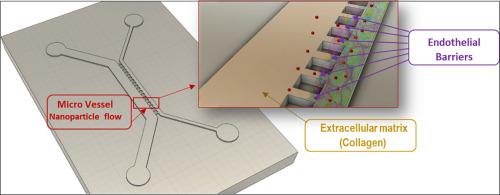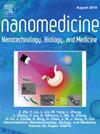Investigation of nanoparticle extravasation pathways in tumor vessel-on-a-chip devices
IF 4.6
2区 医学
Q2 MEDICINE, RESEARCH & EXPERIMENTAL
Nanomedicine : nanotechnology, biology, and medicine
Pub Date : 2025-10-01
DOI:10.1016/j.nano.2025.102863
引用次数: 0
Abstract
The pathways through which nanomedicines extravasate from the bloodstream into solid tumors remain a subject of active investigation. To elucidate this process, we examine the predominant transport mechanisms in vitro using a tumor-vessel-on-chip (TVoC) microfluidic model device. The device comprises a micro-vessel lined with human umbilical vein endothelial cells, positioned adjacent to a compartment containing a collagen-based extracellular matrix. The two compartments are separated by a row of micropillars, where an endothelial barrier naturally forms at the interface within the gaps. Here, transport of different nanoparticles is analyzed under simulated vascular flow conditions. Strengthening endothelial cell junctions to modulate barrier properties led to a nearly 50 % reduction in the permeability coefficient. Furthermore, disruption of intracellular pathways resulted in minimal nanoparticle permeability, which is consistent with the interpretation that the tested nanoparticles predominantly extravasate via the interendothelial route.

纳米颗粒在肿瘤血管芯片装置外渗途径的研究。
纳米药物从血流外渗进入实体肿瘤的途径仍然是一个积极研究的课题。为了阐明这一过程,我们使用肿瘤血管芯片(TVoC)微流控模型装置检查了体外主要的运输机制。该装置包括内衬人脐静脉内皮细胞的微血管,定位于含有胶原基细胞外基质的隔室附近。这两个隔间由一排微柱隔开,在缝隙内的界面处自然形成内皮屏障。本文分析了不同纳米颗粒在模拟血管流动条件下的输运。加强内皮细胞连接以调节屏障特性导致渗透系数降低近50% %。此外,细胞内通路的破坏导致纳米颗粒的渗透性最小,这与所测试的纳米颗粒主要通过内皮间途径外渗的解释一致。
本文章由计算机程序翻译,如有差异,请以英文原文为准。
求助全文
约1分钟内获得全文
求助全文
来源期刊
CiteScore
11.10
自引率
0.00%
发文量
133
审稿时长
42 days
期刊介绍:
The mission of Nanomedicine: Nanotechnology, Biology, and Medicine (Nanomedicine: NBM) is to promote the emerging interdisciplinary field of nanomedicine.
Nanomedicine: NBM is an international, peer-reviewed journal presenting novel, significant, and interdisciplinary theoretical and experimental results related to nanoscience and nanotechnology in the life and health sciences. Content includes basic, translational, and clinical research addressing diagnosis, treatment, monitoring, prediction, and prevention of diseases.

 求助内容:
求助内容: 应助结果提醒方式:
应助结果提醒方式:


